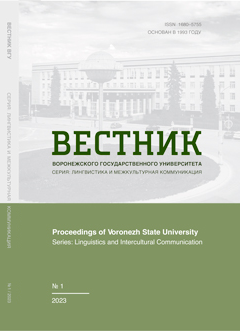Размышления об истории соединения синхронного перевода с искусственным интеллектом в Китае: 2017–2021 гг.
Аннотация
Данная статья посвящена истории развития комплексного использования синхронного перевода и искусственного интеллекта в теоретических трудах китайских авторов за период 2017–2021 гг. Следует отметить, что развитие искусственного интеллекта в Китае является частью государственной системы. При поддержке государства китайские исследователи вносят большой вклад в размышления о роли синхронного переводчика в контексте развития цифровых технологий – искусственного интеллекта. Эволюция этапов развития и взаимного положительного влияния синхронного перевода и искусственного интеллекта, как следует из работ китайских ученых, в основном делится на два главных периода: 2017–2018 гг. и 2019–2021 гг. На первом этапе китайские исследователи изучали роль синхрониста в контексте развития искусственного интеллекта, стремясь найти ответ на вопрос, может ли технология машинного перевода с использованием нейронных сетей полностью заменить переводчика-человека. А после этого, в 2019–2021 гг., фокус китайских исследователей начал изменяться: в их научных работах неоднократно поднимался вопрос, как можно использовать технологии машинного перевода в работе синхрониста-человека. Новизна проведенного исследования заключается в том, что через анализ и сравнение научных работ китайских исследователей в 2017–2021 гг. сформулирована следующая гипотеза: соединение синхронного перевода с искусственным интеллектом в Китае будет развиваться по пути научно-исследовательских работ с дополнением лингвистического корпуса, повышением гибкости и автоматизации системы машинного перевода с использованием нейронных сетей, углублением уровня сотрудничества синхрониста и машины. Этим будут совместно заниматься вузы, научно-исследовательские институты, экспериментальные центры, технические предприятия и компании различных специальностей.
Скачивания
Литература
2. Ministry of Education of the People's Republic of China. Available at: http://www.moe.gov.cn/srcsite/A16/s7062/201804/t20180410_332722.html
3. 邱月烨, 何钰真, 何依蔓,小翻译大 AI,见 《二 十一世纪商业评论》 (TSyu YUehkhua, KHeh YUchzhehn', KHeh Iman. Malen'kij perevod, bol'shoj iskusstvennyj intellect [Small translation and interpreting, but big artifi cial
intelligence]. In: Obozrenie biznesa XXI veka. 2017. No. 4. Pp. 72–73).
4. 刘和平, 雷中华,对口译职业化+专业化趋势的 思考:挑战与对策,见 《中国翻译》(Lyu KHehpin, Lehj CHzhunkhua. Razmyshlenie o tendentsii professionalizatsii + spetsializatsii ustnogo perevoda: problemy i otvetnye mery [Refl ection on the trend of professionalization + specialization of interpreting: problems and responses]. In: Kitajskij perevod. 2017. No. 4. Pp. 77–83).
5. 孙奇茹,人类同传短时间内无可取代, 见《中国 报业》 (Sun' TSizhu. Sinkhronnyj perevodchik nezamenim za korotkoe vremya [Simultaneous interpreter is indispensable in a short time]. In: Kitajskaya pressa. 2018. No. 19. Pp. 107).
6. 杨俊,机器翻译革命强势来袭,见 《中国报业》 (YAn TSzyun'. Revolyutsiya mashinnogo perevoda stremitel'no priblizhaetsya [The machine translation revolution is rapidly approaching]. In: Kitajskaya pressa. 2018. No. 19. P. 107).
7. 赵毅慧,机器口译与人工口译的价值关系研究, 见 《上海翻译》 (CHzhao Ikhuehj. Issledovanie vzaimosvyazi mezhdu mashinnym i chelovecheskim perevodom [Investigation of the relationship between machine and human interpreting]. In: SHankhajskij perevod. 2018. No. 5. Pp. 84–88).
8. 章璇,人工智能发展背景下的同传译员身份流 变,见 《厦门大学外文学院第十一届研究生学术研讨 会暨首届外国语言文学博士论坛论文集》 (CHzhan Syuan'. Transformatsiya sinkhronnogo perevodchika na fone razvitiya iskusstvennogo intellekta [Transformation of a simultaneous interpreter under the background of the development of artificial intelligence]. In: Sbornik 11-go akademicheskogo seminara dlya magistrov fakul'teta inostrannykh yazykov Syamyn'skogo universiteta i Pervogo foruma aspirantоv po inostrannym yazykam i literature. 2018. Pp. 1–13).
9. 沈春泽,人工智能真的可以取代同传翻译吗? 见 《大数据时代》 (Van KHuashu, YAn CHehnshu. SHehn' CHun'tsze. Mozhet li iskusstvennyj intellekt dejstvitel'no zamenit' sinkhronnyj perevod? [Can artifi cial intelligence really replace simultaneous interpreting?]. In: EHpokha bol'shikh dannykh. 2018. No. 11. Pp. 32–39).
10. 李天韵,口译工作模型下的机器同声传译系统 分析,见《东方翻译》(Li Tyan'yun'. Analiz system mashinnogo sinkhronnogo perevoda v rabochej modeli ustnogo perevoda [Analysis of machine simultaneous interpreting systems in the working model of interpreting]. In: Vostochnyj perevod. 2018. No. 6. Pp. 34–39).
11. 余玉秀,AI+翻译:人工智能与语言行为人机耦 合应用研究,见 《传媒》 (TSyu YU YUsyu. Iskusstvennyj intellekt + perevod: Issledovanie primeneniya cheloveko-komp'yuternoj svyazi mezhdu iskusstvennym intellektom i yazykovym povedeniem [Artifi cial Intelligence+Translation and Interpreting: A study of the application of humancomputer communication between artifi cial intelli gence and language behavior]. In: Obozrenie biznesa XXI veka. 2019. No. 8. Pp. 94–96).
12. Zhang Xingyu. A Comparative Analysis on Information Focus in E-C interpretation by AI and interpreters. Dalian University of Technology, 2019. 53 p.
13. 王华树,杨承淑,人工智能时代的口译技术发 展: 概念, 影响与趋势, 见《中国翻译》(Van KHuashu, YAn CHehnshu. Razvitie tekhnologii ustnogo perevoda v ehpokhu iskusstvennogo intellekta: kontseptsiya, vliyanie, i tendentsiya [The development of interpreting technologies in the era of artifi cial intelligence: concept, impact, and trend]. In: SHankhajskij perevod. 2019. No. 6. Pp. 69–79).
14. 李智,李德凤. 人工智能时代口译员信息技术 素养研究, 见 《中国翻译》(Li CHzhi, Li Defehn. Issledovanie informatsionnykh kompetentsij ustnogo perevodchika v ehpokhu iskusstvennogo intellekta [Research of information competencies of an interpreter in the era of artificial intelligence]. In: Kitajskij perevod. 2019. No. 6. Pp. 80–87).
15. 高紫璇 计算机辅助翻译在同声传译中的应用, 见《智库时代》(Gao TSzysyuan'n'. Primenenie mashinnogo perevoda v sinkhronnom perevode [Application of machine translation in simultaneous interpreting]. In: EHpokha mozgovogo tsentra. 2020. No. 7. Pp. 184–185).
16. 肖鸾仪,王艳艳. 模拟机器辅助功能对英汉同 声传译表现的干预研究, 见 《广东第二师范学院学 报》(Cyao Luan'i, Van YAnyan. Issledovanie vliyaniya imitirovannykh mashinnykh vspomogatel'nykh funktsij na vypolnenie sinkhronnogo perevoda s anglijskogo na kitajskij [Investigation of the infl uence of simulated machine auxiliary functions on simultaneous interpreting from English to Chinese]. In: Vestnik Guandunskogo universiteta obrazovaniya. 2020. No. 6. Pp. 52–57).
17. 孙海琴,李可欣,陆嘉威,人工智能赋能语音 识别与翻译技术对同声传译的影响:实验与启示,见 《外语电化教学》 (Sun' KHaj TSin', Li Kehsin', Lu TSzyavehj. Vliyanie tekhnologij raspoznavaniya rechi I perevoda s podderzhkoj iskusstvennogo intellekta na sinkhronnyj perevod: ehksperimenty i otkrytiya [The impact of speech recognition and translation as well as interpreting technologies with artificial intelligence support on simultaneous interpreting: experiments and discoveries]. In: Tekhnologiya uluchsheniya inostrannykh yazykov. 2021. No. 6. Pp. 75–86).
18. 邓军涛, 许勉君,赵田园. 人工智能时代的口 译技术前沿与口译教育信息化, 见 《外语电化教学》 (Dehn TSzyun'tao, Syuj Myan'tszyun', CHzhao Tyan'yuan'. Peredovye tekhnologii ustnogo perevoda i informatizatsiya obucheniya ustnomu perevodu v ehpokhu iskusstvennogo intellekta [The frontier of interpreting Technology and the informatization of interpreting education in the era of artificial Intelligence]. In: Kitajskij perevod. 2021. No. 4. Pp. 67–72, 79).













